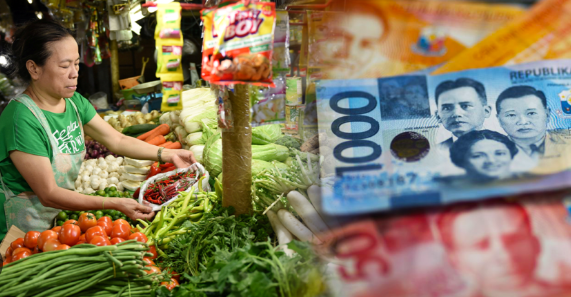The Bangko Sentral ng Pilipinas (BSP) has projected the October 2024 inflation rate to fall within a range of 2.0% to 2.8%, highlighting various economic factors that influence consumer prices in the country.
In its months ahead forecast, the Philippine central bank acknowledges both upward and downward pressures on inflation yet their forecast remains relatively contained, a sign of cautious optimism as the Philippine economy navigates ongoing price challenges.

Earlier in August this year, the BSP announced that the country’s inflation rate could fall within the range of 3.2% to 4.0%. This forecast came at a time when the Philippine economy is facing a mix of inflationary pressures and mitigating factors, leading to cautious optimism about the country’s economic stability in the coming months.
BSP sees food and fuel as key inflationary drivers
BSP reports that the main drivers of inflation for October are the rising prices of food commodities, including vegetables, fruits, and fish. Seasonal shifts and logistical disruptions have strained local food supplies, pushing prices upward.
This is further exacerbated by an increase in domestic petroleum prices, partly driven by global oil market fluctuations and currency depreciation.
The recent weakening of the Philippine peso adds an additional layer of complexity to the country’s inflation outlook. A lower peso increases import costs, which affect essential goods such as fuel and food ingredients.
For an import-dependent economy like the Philippines, peso depreciation directly impacts consumer prices, further heightening inflationary pressures.
Offsetting factors: Rice, meat, and electricity
Despite these upward pressures, the BSP identified several factors that could help temper inflation for the month. The easing of rice prices is one of the more significant factors, following the government’s intervention to stabilize this staple commodity.
Authorities recently introduced measures to control rice prices, which have yielded a modest decline in retail costs, benefiting households and lessening the strain on average consumers.
Additionally, the cost of meat products has also seen a reduction, which helps counterbalance the inflationary pressures in other food categories.
The BSP also noted a decrease in electricity rates as well, attributed to favorable conditions in the energy sector, which reduces household expenses.
Lower electricity bills offer relief to Filipino families and allow for better control of disposable income, which can positively affect consumer spending across other sectors.
Balancing act: The BSP’s measured approach to monetary policy

To navigate these inflation dynamics, the BSP’s Monetary Board remains committed to a “measured approach” to monetary policy. Ensuring price stability is crucial to fostering balanced and sustainable growth across the broader economy, which includes keeping inflation within manageable levels while encouraging employment.
According to BSP Governor Eli Remolona, this approach involves a careful balancing of interest rates and liquidity in the economy to avoid excessive inflation without stifling economic growth.
“Our objective is to support an environment where price stability is conducive to sustainable economic expansion and job creation,” Remolona said.
This approach aligns with the central bank’s broader goal of maintaining a healthy economic environment for businesses and consumers alike.
Economic implications: Growth and employment
Inflation control remains a central pillar of BSP’s strategy for supporting economic growth in the Philippines. When inflation is kept within a manageable range, businesses and households can plan their finances with greater confidence, supporting a stable economic environment.

By stabilizing food, energy, and commodity prices, BSP aims to shield the economy from the potentially destabilizing effects of runaway inflation.
For the Philippine banking and finance sector, controlled inflation rates provide favorable conditions for lending and investment activities.
Banks benefit from a stable economic outlook, which boosts confidence among borrowers and investors.
A predictable inflation rate also helps set clearer expectations for interest rates, allowing financial institutions to adjust their strategies accordingly.
External factors and local policy interventions
As the Philippines heads into the final months of 2024, the BSP will continue monitoring both global and domestic trends affecting inflation. With geopolitical tensions and unpredictable global oil prices, the BSP faces external pressures that could affect inflation in the near term.
Locally, the central bank may consider additional policy measures to support the Philippine peso and further stabilize commodity prices if necessary.
Moreover, collaborations between government agencies and private entities to improve food supply chains and energy production are expected to mitigate some inflationary pressures.
Continued investments in agriculture and infrastructure could provide long-term solutions to the current inflation challenges, creating a more resilient economy.
The BSP’s October inflation forecast highlights a nuanced view of the Philippine economy, acknowledging both the pressures and opportunities shaping inflation rates.
With efforts focused on maintaining price stability, the BSP aims to support a balanced economic recovery that promotes growth and job creation. This commitment to a measured, data-driven approach underscores the central bank’s role in fostering economic resilience and stability, laying the groundwork for a more secure financial future for Filipinos.







